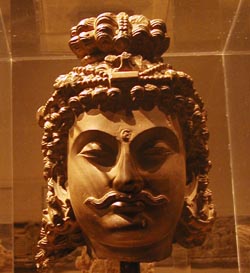
Matter and life exist because of asymmetry
Research in Spontaneous Generation and Propagation of Chiral Asymmetry
|
Matter and life exist because of asymmetry |
Research in Spontaneous Generation and Propagation of Chiral Asymmetry
|
Introduction: Chiral Asymmetry in Nature
From elementary particles to the morphology of mammals, nature
exhibits a preference for one hand over the other. This fact immediately raises
two questions:
• What are the origins of this ubiquitous asymmetry ?
• Are the asymmetries we observe at various levels -- elementary
particles, biomolecules and animal morphology -- somehow related ? If so, how
does asymmetry at one level propagate to the next level ?
The answer to these questions lies in the phenomenon of spontaneous chiral symmetry breaking and the sensitivity of this process to small chiral influences. The general overview of this subject can be found in the following article and book.
R. Hegstrom and D.K. Kondepudi, The Handedness of the Universe, Scientific American, 262 ( Jan. 1990) Pages 108 - 115
R. Janoschek (Ed.) Chirality - From Weak Boson to the Alpha-Helix, 1991 Springer-Verlag, New York
• Asymmetry in Spiral Galaxies?: Our preliminary study of the statistics of S- and Z-shaped spiral galaxies show that a particular form of chiral asymmetry exists when the ordinary and barred spiral galaxies are analyzed separately. More work needs to be done to confirm this result.
D.K. Kondepudi and Daniel J. Durand. Chiral Asymmetry in Spiral Galaxies? Chirality 13(2001) 351-356
Research Highlights
• A general
theory of spontaneous chiral symmetry breaking in chemical systems has been
formulated. The fundamental equations of this theory depend only
on the two-fold mirror-image symmetry and not on the details of the chemical
kinetics. Close to equilibrium, the system will be in a symmetric state in which
the amounts of the two enantiomers of all chiral molecules are equal. When the
system is driven away from equilibrium by a flow of chemicals, a point is reached
at which the system becomes unstable to small fluctuation in the difference
in the amount of the two enantiomers. As a consequence, a small random fluctuation
in the difference in the amount of the two enantiomers spontaneously grows and
the system makes a transition to an asymmetric state. The general theory describes
this phenomenon in the vicinity of the transition point.
• The above theory can be extended to predict the effect of small asymmetric influences on symmetry-breaking transitions. Given the strength of the asymmetric influence, the size of the random fluctuations and the rate at which the system passes through the critical point, the probability with which a particular state of asymmetry is reached. This theory and its generalization can be found in the in the following article:
D.K. Kondepudi and G.W. Nelson , Weak Neutral Currents and the Origin of Biomolecular Chirality, Nature, 314 (1985) pp. 438 - 441
D.K. Kondepudi and M-J. Gao, Passage Through the Critical Point and the Process of State Selection in Symmetry Breaking Transitions Phys. Rev. A, 35 (1987) 340 - 348
D.K. Kondepudi, State Selection Dynamics in Symmetry Breaking Transitions in Noise in Nonlinear Dynamical Systems Vol.2, F. Moss and P.V.E.McClintock (Eds). ( Cambridge University Press, 1989) pp: 251-270
• Chiral Symmetry Breaking in Stirred
Crystallization can be observed in a very simple process.
NaClO3 is an achiral compound that crystallizes in chiral forms, i.e., the crystals
are optically active though NaClO3 is not a chiral molecule. Each crystal is
either levo(l)- or dextro(d)-rotatory. The optical activity of NaClO3 crystals
(which are isotropic) can easily be seen using a pair of polarizers. In a typical
crystallization of NaClO3, that is done in a crystallization or petri dish,
for example, statistically equal number of l- and d-crystals are obtained. However,
if the crystallization is done in a beaker while the solution is continuously
stirred, each crystallization produces almost all (>98%) l- or almost all
d- crystals ! In a particular crystallization, l- or d-crystals dominate randomly
with a probability of 0.5.
The phenomenon of chiral symmetry breaking in stirred crystallization can also
be observed in many other systems and it is quite general. The following articles
discuss this topic in detail.
D.K. Kondepudi, R. Kaufmann and N. Singh. Chiral Symmetry Breaking in Sodium
Chlorate Crystallization, Science 250 (1990) 975 - 976
D.K. Kondepudi, K.L. Bullock, J.A. Digits, J.K. Hall and J. Miller. Kinetics
of Chiral Symmetry Breaking in Crystallization J. Am.
Chem. Soc. 115 (1993) 10211-10216
D.K. Kondepudi, K. Asakura and J. Laudadio. Chiral Symmetry Breaking in
Stirred Crystallization of Binaphthyl Melt J. Am. Chem.
Soc. 121 (1999)1448-1451
D. K. Kondepudi and K. Asakura, Chiral Autocatalysis, Spontaneous Symmetry Breaking, and Stochastic Behavio., Accounts of Chemical Research, 34(2001) 946-954.
Publications related to this topic(PDF)
To request a copies of articles, please send email to: dilip@wfu.edu
More under construction!!